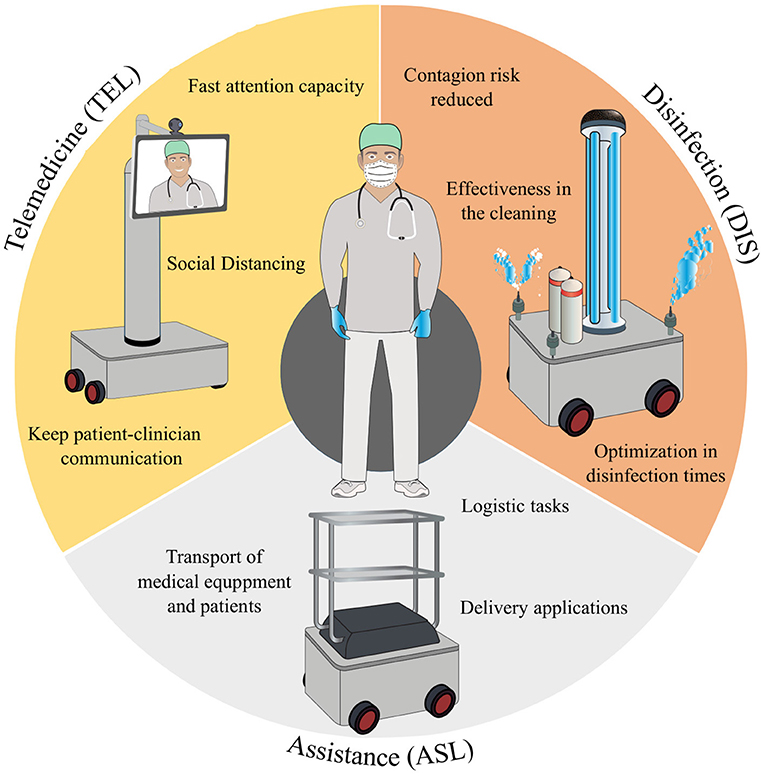
Robohub.org
Expectations and perceptions of healthcare professionals for robot deployment in hospital environments during the COVID-19 pandemic

Image extracted from [1].
The recent outbreak of the severe acute respiratory syndrome, caused by coronavirus 2 (SARS-CoV-2), also referred to as COVID-19, has spread globally in an unprecedented way. In response, the efforts of most countries have been focused on containing and mitigating the effects of the pandemic. Given the transmission rate of the virus, the World Health Organization (WHO) recommended several strategies, such as physical distancing, to contain the spread and widespread transmission. Driven by other factors, including the effects of this pandemic on the economy, some countries are now resuming economic activities, making it all the more necessary to ensure compliance with bio-safety protocols to contain further spread of the virus. So, the background to our project is this diverse landscape of different public health measures that are having to be adopted around the world, oftentimes with the measures being iteratively refined by the authorities as their impacts on the social, economic, and political sectors become clearer.
In the health sector, all levels and different stakeholders of the world’s health systems have been unwaveringly focused on providing medical care during this pandemic. The demands on the health systems remain high despite the successful rollouts of vaccination among many in this population across the globe. Numerous challenges have arisen, such as (1) the vulnerability and overloading of healthcare professionals, (2) the need for decongestion and reduction in the risk of contagion in intra-hospital environments, (3) the availability of biomedical technology, and (4) the sustainability of patient care. As a consequence, multiple strategies have been proposed to address these challenges. For instance, robotics is a promising part of the solution to help control and mitigate the effects of the COVID-19.
Although the literature has shown some robotics applications to be able to overcome the potential hazards and risks in hospital environments, actual deployments of those developments are limited. Interestingly, few studies measure the perception and the acceptance among clinicians of these robotics platforms. This work [1] presents the design and implementation of several perception questionnaires to assess healthcare providers’ level of acceptance and awareness of robotics for COVID-19 control in clinical scenarios. The data of these results are available in a public repository. Specifically, 41 healthcare professionals (e.g., nurses, doctors, biomedical engineers, among others, from two private healthcare institutions in the city of Bogotá D.C., Colombia) completed the surveys, assessing three categories: (DIS) Disinfection and cleaning robots, (ASL) Assistance, Service, and Logistics robots, and (TEL) Telemedicine and Telepresence robots. The survey revealed that there is generally a relatively low level of knowledge about robotics applications among the target population. Likewise, the surveys revealed that some fear of being replaced by robots very much remains in the medical community. However, 82.9 % of participants indicated a positive perception concerning the development and implementation of robotics in clinical environments.
The outcomes showed that the healthcare staff expects these robots to interact within hospital environments socially and communicate with users, connecting patients and doctors in this sense. Related work [2] focused on Socially Assistive Robotics presents a potential tool to support clinical care areas, promoting physical distancing, and reducing the contagion rate. The paper [2] presents a long-term evaluation of a social robotic platform for gait neurorehabilitation.
The social robot is located in front of the patient during the exercise, guiding their performance through non-verbal and verbal gestures and monitoring physiological progress. Thus, the platform enables the physical distancing between the clinicians and the patient. A clinical validation with ten patients during 15 sessions was conducted in a rehabilitation center located in Colombia. Results showed that the robot’s support improves the patients’ physiological progress. It helped them to maintain a healthy posture, evidenced in their thoracic and cervical posture. The perception and the acceptance were also measured in this work, and Clinicians highlighted that they trust the system as a complementary tool in rehabilitation.
Previous studies before the pandemic showed that clinicians were worried about being replaced by the robot before any real interaction in their environments [3]. Considering the robot’s role during the COVID-19 pandemic, clinicians have a positive perception of the robot used as a tool to manage the rehabilitation procedures. Most healthcare personnel will consent to use the robot during the pandemic, as they consider this tool can promote physical distancing. It is a secure device to carry out the healthcare protocol. Another encouraging result is that clinicians recommend the robot to other colleagues and institutions to support rehabilitation during the COVID-19 pandemic.
These works are funded by the Royal Academy of Engineering – Pandemic Preparedness (Grant EXPP20211\1\183). This project aims to develop robotic strategies in developing countries for monitoring non-safety conditions related to human behaviors and planning processes of disinfection of outdoor and indoor environments. This project configures an international cooperation network led by the Colombian School of Engineering Julio Garavito, with leading Investigator Carlos A. Cifuentes and the University of Edinburgh support by Professor Subramanian Ramamoorthy along with researchers and clinicians from Latin America (Colombia, Brazil, Argentina, and Chile).
References
- Sierra, S., Gomez-Vargas, D., Cespedes, N., Munera, M., Roberti, F., Barria, P., Ramamoorthy, S., Becker, M., Carelli. R. Cifuentes, C.A. (2021) Expectations and Perceptions of Healthcare Professionals for Robot Deployment in Hospital Environments during the COVID-19 Pandemic. Frontiers in Robotics and AI.
- Cespedes N., Raigoso, D., Munera, M., Cifuentes, C.A. (2021) Long-Term Social Human-Robot Interaction for Neurorehabilitation: Robots as a tool to support gait therapy in the Pandemic, Frontiers in Neurorobotics.
- Casas, J. Cespedes, N., Cifuentes, C.A., Gutierrez, L., M., Rincon-Roncancio, Munera, M., (2019). Expectations vs Reality: Attitudes Towards a Socially Assistive Robot in Cardiac Rehabilitation. Appl. Sci, 9(21), 4651.
tags: c-Research-Innovation








